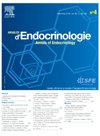Kisspeptin系统-生理学和临床观点。
IF 2.9
3区 医学
Q3 ENDOCRINOLOGY & METABOLISM
引用次数: 0
摘要
目的:综述对kisspeptin的认识现状。kisspeptin可以改变某些类型癌细胞的迁移特性,并在生殖轴的控制中起重要作用。方法:PubMed检索,识别最新的相关信息。结果:综述了kisspeptin释放调控的生理方面及其在生殖轴调控中的地位。讨论了Kisspeptin在青春期的作用及其与男性和女性生殖轴的相互作用以及潜在的临床前景。进一步分析了kisspeptin与中枢作用代谢因子的相互作用,并分析了kisspeptin系统在生殖道外的一些器官(胰腺、肝脏和脂肪组织)中的存在。kisspeptin系统是改变各种癌症类型(恶性黑色素瘤、乳腺癌、结直肠癌、胃癌、甲状腺癌、肝细胞癌等)转移潜能的因素。此外,据报道kisspeptin还能诱导已经播散的肿瘤细胞休眠,从而抑制转移性肿瘤在多个器官的定植。结论:kisspeptin系统可为某些生殖疾病的治疗提供额外的诊断试验甚至治疗靶点和程序。作为一个参与抑制转移的因素,它可能在未来对各种癌症类型的预后和/或随访有重要的价值。本文章由计算机程序翻译,如有差异,请以英文原文为准。
Kisspeptin system–physiology and clinical perspectives
Purpose
To summarize the state of knowledge on kisspeptin, a factor that alters the migration properties of some types of cancer cell and also plays an important role in the control of the reproductive axis.
Methods
PubMed search, identifying the most recent relevant information.
Results
This review describes the physiological aspects about the regulation of kisspeptin release and its place in the regulation of reproductive axis. Kisspeptin's role in puberty and its interaction with male and female reproductive axis are discussed along with potential clinical perspectives. Further analysis was made of the interaction of kisspeptin with centrally acting metabolic factors and on the presence of the kisspeptin system in some organs outside the reproductive tract: pancreas, liver, and adipose tissue. The kisspeptin system is a factor that alters the metastatic potential in various cancer types–malignant melanoma, breast cancer, colorectal cancer, gastric carcinoma, thyroid carcinoma, hepatocellular carcinoma, etc. Additionally, kisspeptin has also been reported to induce dormancy in already disseminated tumor cells, thus suppressing metastatic colonization in multiple organs.
Conclusion
The kisspeptin system could in future provide additional diagnostic tests and even therapeutic targets and procedures for the management of some reproductive disorders. As a factor involved in suppression of metastasis, it may in future have significant value for prognosis and/or follow-up in various cancer types.
求助全文
通过发布文献求助,成功后即可免费获取论文全文。
去求助
来源期刊

Annales d'endocrinologie
医学-内分泌学与代谢
CiteScore
4.40
自引率
6.50%
发文量
311
审稿时长
50 days
期刊介绍:
The Annales d''Endocrinologie, mouthpiece of the French Society of Endocrinology (SFE), publishes reviews, articles and case reports coming from clinical, therapeutic and fundamental research in endocrinology and metabolic diseases. Every year, it carries a position paper by a work-group of French-language endocrinologists, on an endocrine pathology chosen by the Society''s Scientific Committee. The journal is also the organ of the Society''s annual Congress, publishing a summary of the symposia, presentations and posters. "Les Must de l''Endocrinologie" is a special booklet brought out for the Congress, with summary articles that are always very well received. And finally, we publish the high-level instructional courses delivered during the Henri-Pierre Klotz International Endocrinology Days. The Annales is a window on the world, keeping alert clinicians up to date on what is going on in diagnosis and treatment in all the areas of our specialty.
 求助内容:
求助内容: 应助结果提醒方式:
应助结果提醒方式:


